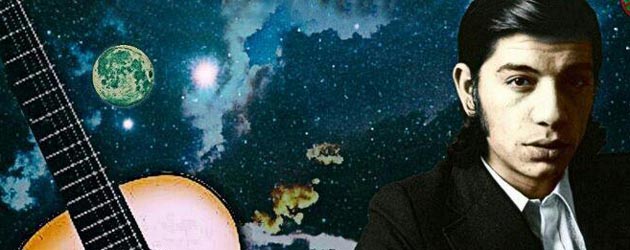Estela Zatania
Just like that, he's gone. An ill wind blew in from the marsh and carried away the fragile bohemian genius named Miguel Vega de la Cruz, son of Miguel el Tomate and uncle of Tomatito, our much-admired Niño Miguel, born and gone in Huelva.
A “niño” who was more like an old man, not just his body, because at 61 most people still have plenty of energy, but his spirit. There was a bright flash of absolute fame – Paco de Lucía would say of him that he was one of the best flamenco guitarists of all time – a promising recuperation and then…the void.

Those were heady flamenco times when everything was moving along quickly. In just about two years, from 1973 to 1975, three ground-breaking compositions had come from three geniuses of the guitar: Paco de Lucía’s “Entre dos Aguas”, Manolo Sanlúcar’s “Caballo Blanco” and “Vals Flamenco” of Niño Miguel left a mark on the history of the genre, and established the viability of instrumental flamenco, so important in today’s music market. The Huelva man, youngest of the three, achieved a level of fame which, due to various problems, he would never be able to develop or take advantage of. The decades came and went…he was neither sought nor found, just lost…aimlessly roaming the streets of his hometown.
After briefly being brought back to the stage by his friend, the great guitarist Juan Carlos Romero, to give a surprising recital in Seville in 2005, I received a call from the Huelva radio station: “We saw your review…does this guy really play that well?” asked the journalist in Huelva barely containing his amusement. “We’re used to him here, he’s always in the street barefoot, every city has to have a crazy guy, don’t you think?…does he really play guitar?” I answered yes, and that it was necessary to care for him, get him off the street, give him a half-decent guitar… And I received word that some well-meaning individuals did try to improve his condition, give him medical care and also a guitar…which was soon either lost or stolen. And in 2007, we were all in tears at the Teatro Central when Romero dedicated a piece to Niño Miguel, and the musicians played barefoot in a gesture of solidarity with that lost soul.
He made two records. Two. Less than a year ago, a documentary came out, “La Sombra de las Cuerdas” (the shadow of the strings), by Annabelle Ameline, Benoît Bodlet y Chechu García-Berlanga, on the life and work of Niño Miguel. In 2009, he received a grand tribute in Huelva, and again played in Seville in 2011. In his hometown of Huelva, a plaza was named after him. Gestures of admiration that perhaps came too late for a soul that finally found freedom in loneliness, and the permanent poignant dialogue with his guitar.
The following review is what I wrote about that historic recital in 2005:
Niño Miguel at the Sala Joaquín Turina, Seville
Thursday, March 10th, 2005.
Flamenco the way it was played just before another generation set out on their long march toward experimentalism
Writer P.D. James wrote that “Creativity is the successful resolution of internal problems”. We don’t know whether the reappearance of Niño Miguel is due to any such mental peace, but a few days ago this guitarist, born two years after Camarón de la Isla, touted in his adolescence as the one who would wipe Paco de Lucía off the map, had the courage to do what few current stars of the guitar would risk: a recital of nearly one hour, solo, without cajón or palmas or Indian drums. As if emerged from a time capsule, with the associated advantage of not having become “contaminated” by jazz, he played flamenco the way it was played just before another generation set out on their long march toward experimentalism with alternative tunings, “green” chords as we used to call them and correct but hidden compás that no longer involves listeners with the same urgency.
There was heavy emotional baggage. His frail, wasted appearance, far beyond what you would expect after the passage of thirty years’ time, triggered a muffled gasp among those of us of a certain age who remember the face of that adolescent who would become king. He took his seat, apologized saying something about being “a little under the weather” and started pulling beautiful and mysterious sounds from his guitar with a dynamic attack, owing a great deal to Paco de Lucía, no question about that, with the occasional nod to Sabicas but always with his own personality and a fair amount of original material which fell surprisingly fresh upon our ears. He acknowledged the first enthusiastic applause with extreme humility, almost shame.
You could tell he was intimate friends with his instrument. He would fine-tune on the fly like the most seasoned professional, and modulated between keys with absolute authority. You would have expected worse technique, and certainly he was a long way from current standards, missing notes here and there, but he accomplished no small feat given the difficulty of the material. His left hand seemed up to the task, the one that creates the positions, but his working hand was off, the one that strums and picks, as was his coordination between both. Were he so inclined, he could approach the level of today’s best with a few months of dedicated study, but unfortunately for flamenco fans, that is highly unlikely to happen.
He played lengthy pieces that did not sound like “themes”, but rather the old system of melodic excursions linked by rhythmic phrases that kept us on track and prepared the ear for ever more sophisticated falsetas. There was not one dull moment and it was impossible to avoid wistfully recalling a Paco de Lucía who used to be more flamenco than now – the handwriting on the wall for many of today’s virtuoso players.
